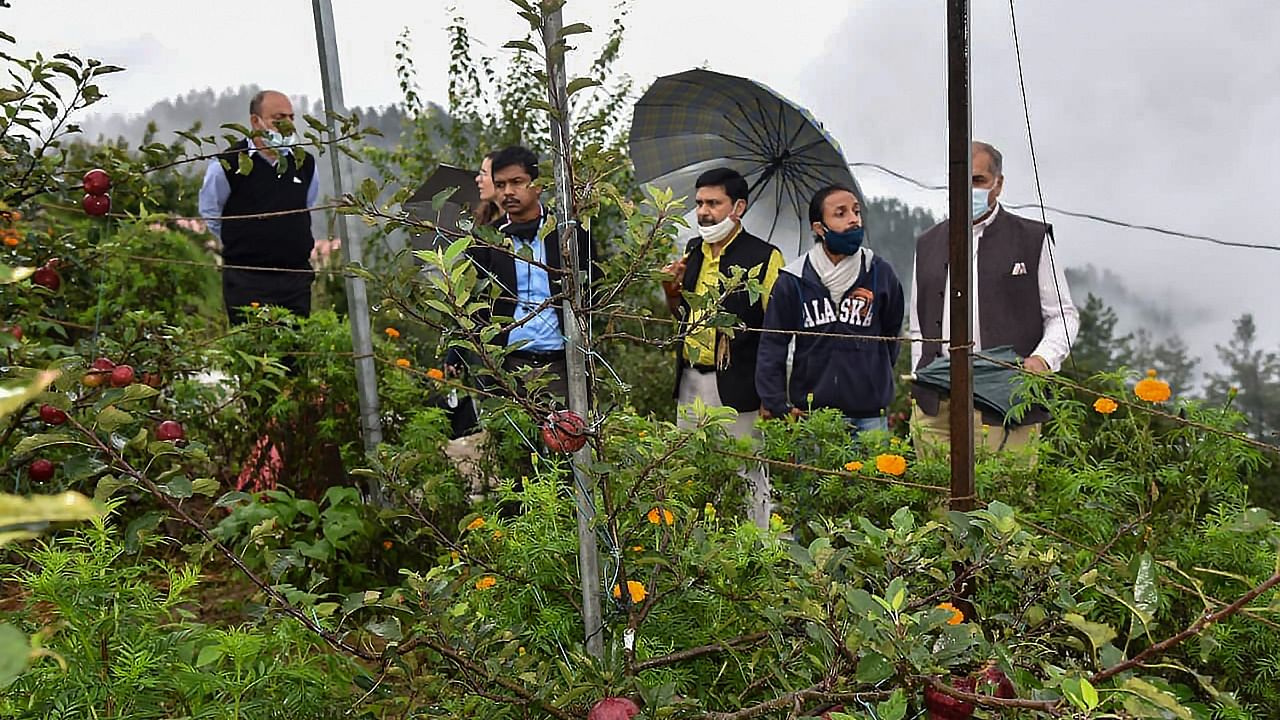
An almost deserted apple orchard at the regional horticulture research station of Dr Y S Parmar University of Horticulture and Forestry, Solan is full of lush fruit trees and inter-crops thanks to a unique natural farming technique.
Promoted by the Himachal Pradesh government under the “Prakritik Kheti Khushhal Kisan Yojana (PK3Y)”, the Subhash Palekar Natural Farming (SPNF) technique, has turned the orchard at the research station in Mashobra near here productive.
SPNF is non-chemical natural farming concept given by Padma Shri Subhash Palekar and is based on farm inputs prepared from urine and dung of indigenous cows in the farm itself.
It reduces the cost of cultivation drastically as the farmer is not required to buy inputs from the market.
“The SPNF intervention on the orchard with the same old plants, which had to be abandoned some years back for lack of resources, has shown encouraging results over the last two years. With the use of natural inputs like jeevaamrit and ghanjeevaamrit prepared from dung and urine of desi cow, the overall health of the orchard has improved,” said Associate Director at the Research Station, Dr Pankaj Gupta.
Seven apple varieties are growing in the orchard under SPNF, including gala, origon, and red chief.
Executive Director, PK3Y, Dr Rajeshwar Singh Chandel visited the orchard earlier this week and said besides apples, the university is also doing some experiments on vegetable crops. Two young agriculture researchers, Shahzad Prabhoo from Maharashtra and Carole Durand from France, accompanied Chandel for exposure.
The apple orchard measures less than one hectare and the research station proposes to bring more area under the SPNF shortly.
The PK3Y had funded Rs 67 lakh to the research station for the scientific trial on SPNF technique, along with setting up of infrastructure, in 2019 and Rs 19 lakh in 2020.
The research station has also kept a 'pahari' cow to follow SPNF in toto and plans to buy two more indegenous cows at the farm.
The apple orchard, which was giving negligible returns for many years for want of any application, gave estimated gross returns of around Rs 3,61,162 per hectare in 2019 after SPNF intervention, which increased to Rs 5,46,964 per hectare in 2020.
“The terminal growth in the orchard had stopped and the soil quality was very poor. However, since we adopted the orchard for trial under SPNF technique, the terminal growth is revived and the soil structure (porosity, water retention and texture) has improved. The earthworm population has increased. The plants are now healthy and the leaf size is good,” said Dr Usha Sharma, Scientist, Plant Pathology at the research station, who is supervising the SPNF trial.
“We will carry on with the experiment for five years to establish and validate the success of the technique. Many issues are still emerging in SPNF technique in the apple orchard and we are accordingly improvising,” she said.
She said the beneficial mites in the orchard have increased with SPNF technique compared to the orchard managed by chemical farming.
The SPNF has evidently given a new lease of life to the orchard as it has not only improved the apple plants, but has given an opportunity to go for inter-cropping in the same land.
As a part of the SPNF experiment, the scientists took four crops alongside apples from the same orchard starting from peas to methi, beans and then rajma to supplement nutrients in soil and the overall economy.
The model of revival of the apple orchard by SPNF technique has become an attraction for researchers and officials lately, who are visiting the place in good numbers for exposure.
As many as 1,29,299 farmers have adopted the SPNF technique under the PK3Y since 2018 in Himachal Pradesh, involving an area of 7456 hectares. This includes 12,000 apple growers.
Check out DH's latest videos: